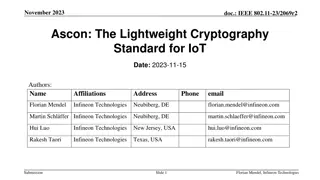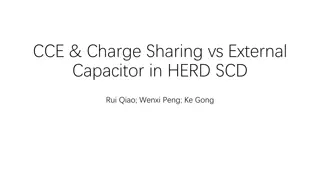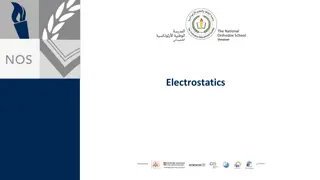Comparative Analysis of Positive Charge's Charging Stations Evolution
This PowerPoint template example created by Romy Bailey for Positive Charge showcases a comparative study of high-speed charging stations versus traditional charging stations, along with a comparison of past year versus current year data, and a year-over-year analysis of Positive Charge's growth. It
1 views • 6 slides
Computer Peripherals and Interfacing
Computer peripherals are external devices that enhance the functionality of a computer. They include input devices like keyboards and mice, output devices like printers and monitors, and storage devices like hard disk drives and solid-state drives. Interfacing circuits connect these peripherals to t
1 views • 6 slides
Ascon: The Lightweight Cryptography Standard for IoT
The November 2023 document IEEE 802.11-23/2069r2 discusses the importance of secure data storage and communication in IoT devices due to the increasing number of connected devices and potential security threats. It introduces Ascon as a lightweight cryptography standard selected by NIST for protecti
0 views • 26 slides
Lightweight Cryptography Standard for IoT - November 2023 IEEE Presentation
IEEE 802.11-23/2069r1 presents Ascon as a lightweight cryptography standard for IoT devices. With the increasing number of connected devices, protecting data on IoT devices becomes crucial. NIST selects Ascon to safeguard small devices, offering authenticated encryption and hashing efficiently. Asco
3 views • 26 slides
Understanding Network Devices and Connectivity
Network devices play a crucial role in connecting computers and printers to networks, facilitating fast and secure data transfer. These devices, such as network interface cards and WiFi cards, help devices communicate effectively on the same or different networks. MAC addresses uniquely identify dev
6 views • 31 slides
Understanding Input and Output Devices in Computing
In computing, input and output devices play a crucial role in enabling communication between users and computers. Input devices are used to enter data into a computer, while output devices display or provide the results of processed information. Common input devices include keyboards, mice, and joys
0 views • 17 slides
Understanding Basic Input/Output Operations in Computer Organization
Basic Input/Output Operations are essential functions in computer systems that involve transferring data between processors and external devices like keyboards and displays. This task requires synchronization mechanisms due to differences in processing speeds. The process involves reading characters
0 views • 11 slides
Understanding Electronic Components and Input/Output Devices
Explore the world of electronic components, input devices, and output devices through energy changes and symbol representations. Learn about LEDs, resistors, and energy conversions in a hands-on manner. Discover the role of various devices like microphones, solar cells, loudspeakers, and diodes in c
1 views • 24 slides
Understanding Computer Peripheral Devices: Definition, Examples, and Types
Learn about computer peripheral devices, which enhance a computer system's functionality. Examples include mice, keyboards, monitors, printers, and scanners. These devices can be categorized into input, output, and storage devices, each serving a specific purpose to expand the capabilities of your c
2 views • 13 slides
Positive Charge Brand Audit Presentation
Conducting a brand audit is crucial to evaluate the effectiveness of Positive Charge, an EV-charging provider striving to reduce the environmental impact of fossil-fuel cars. The audit covers aspects such as brand identity, customer perception, values, competition analysis, and goals alignment to de
0 views • 7 slides
Understanding Programmable Logic Devices (PLD) in Digital Electronics
Programmable Logic Devices (PLDs) are versatile electronic components used to create reconfigurable digital circuits, distinct from fixed-function integrated circuits. PLDs require programming before use, enabling customization for specific functions. This article explores PLDs, digital electronic s
0 views • 10 slides
Automotive Grade 10 Joining Methods: Locking Devices Overview
Automotive Grade 10 explores joining methods using locking devices to prevent nuts from loosening due to movement and vibration. Friction-locking devices include lock nuts, stiff nuts, and special washers. Positive-locking devices tighten nuts securely with slotted nuts, crowned nuts, tab washers, a
1 views • 7 slides
Understanding Current, Resistance, and Charge Motion
Explore the fundamentals of current flow, resistance, and charge motion in this chapter. Learn about the factors influencing current, the behavior of free electrons in metals, and the impact of potential difference on charge motion. Discover Kirchhoff's laws and how current density is calculated.
0 views • 40 slides
Understanding Electrostatic Sensitive Devices (ESDS)
Electrostatic Sensitive Devices (ESDS) are susceptible to damage caused by electrostatic discharge (ESD). This results from the transfer of electrostatic charge induced by high electrical fields. ESD can alter the characteristics of semiconductor devices, leading to malfunctions or failures in elect
0 views • 34 slides
Laser-Controlled Competing Superconducting and Charge Orders in Transition Metal Dichalcogenides
Hamburg Theory of laser-controlled competing superconducting and charge orders explores the use of lasers to manipulate the ordering mechanisms in transition metal dichalcogenides, leading to ultrafast switching and the induction of new states of matter. This research delves into generic mechanisms
0 views • 13 slides
Overview of Computer Input and Output Devices
Input devices of a computer system consist of external components like keyboard, mouse, light pen, joystick, scanner, microphone, and more, that provide information and instructions to the computer. On the other hand, output devices transfer information from the computer's CPU to the user through de
0 views • 11 slides
Understanding Electric Charges and Conductors in Physics
Explore the fundamentals of electrostatics, electric charges, conductors, and insulators in physics. Learn about the Law of Electric Charges, types of charge, conductors vs. insulators, and methods of charging objects through friction, conduction, and induction. Dive into the world of atoms, electro
1 views • 14 slides
Understanding Wind Power Generation Principles
Exploring the fundamental concepts of wind power generation, this content discusses the relationship between kinetic energy, air mass, and wind energy. It delves into the calculation of wind power using air density, velocity, and swept area, providing insights into how wind power efficiency varies w
0 views • 10 slides
Understanding Basics of Computer Systems
A computer is an electronic device that stores and processes data using hardware and software components. It consists of a CPU, memory, storage devices, input/output devices, and communication devices. The CPU includes a Control Unit and Arithmetic Logic Unit, and the memory stores data in bytes. St
0 views • 57 slides
Procedures and Criteria for Adjudication of Charges by Chief Magistrate
The process of adjudicating charges returned by the Chief Magistrate involves detailed steps, including review by the governor adjudication level and independent adjudicator referral. Factors such as procedural fairness, evidence quality, and seriousness of the charge are considered. If a charge is
0 views • 5 slides
Understanding Electric Fields and Charges in Different Scenarios
Explore various scenarios involving electric fields and charges such as the E-field at the center of a conducting sphere, the effect of total charge on E-field, E-field above a charged conductor, charge distribution on the surface of a copper sphere with a hollow, field inside a charged non-conducti
0 views • 9 slides
Comparison of Charge Sharing Mechanisms in HERD SCD
This study delves into the analysis of charge sharing mechanisms in the HERD SCD using simulations and experimental data. It explores the impact of coupling capacitors on charge sharing efficiency and readout strip performance under various conditions to enhance signal detection and improve CCE. The
0 views • 21 slides
New Centralized Eligibility Process (ODH Form 1341/1341A) for Take Charge!
Learn about the new centralized eligibility process for Take Charge! training, including who is required to take it, the goals and objectives, overview, general eligibility criteria, and options for determining Take Charge! eligibility.
0 views • 23 slides
Understanding Electric Current and Electric Potential Difference
Electric current is the flow of electrons moving from one point to another, measured in amperes. The direction of current follows convention, even though electrons actually move oppositely. Current is calculated using the total charge passing a point in a given time. Electric Potential Difference (E
0 views • 22 slides
Security Concerns and Future Challenges of Internet Connected Devices in Budva, Montenegro
With the increasing number of Internet-connected devices and IoT, the security concerns are escalating. In the past, communication was restricted to servers and terminals, but now everyone is connected globally. The future poses even greater risks with IoT becoming prevalent. Reasons for concern inc
0 views • 17 slides
Analysis of Resolution Study and Charge Scans on 17th Feb 2017
Detailed analysis conducted on 17th Feb 2017 includes resolution calculations, charge scans, attenuation comparisons, and improvements in data fitting. The study compares measured resolutions with predicted scaling, examines the impact of additional information on fitting, and explores peak shifts i
0 views • 30 slides
Charge Transport Model for Swept Charge Devices (SCD) in Astrophysics Research
Exploring the charge transport model for Swept Charge Devices (SCD) in collaboration with various institutions like ISRO Satellite Centre and e2V technologies Ltd. The research aims to enhance spectral response, reduce uncertainties, and improve global lunar elemental mapping using advanced X-ray sp
0 views • 30 slides
Zephaniah: The Savior's Summons to Satisfaction
Stage 2 of the Savior's Summons to Satisfaction in Zephaniah includes the Charge to Wait for the Lord, the Dual Basis of the Charge to Wait, and the Ultimate Motivation of the Charge to Wait. The promise of not putting Jerusalem to shame, a call to rejoice in salvation, and the assurance of consumma
0 views • 10 slides
Understanding Intermolecular Forces in Chemistry
Interactions between static charge distributions in chemistry are governed by Coulomb's Law, playing a crucial role in understanding intermolecular forces. From ion-ion interactions to charge-dipole and charge-quadrupole interactions, the strength of forces varies based on factors like distance and
0 views • 21 slides
Understanding Charge Negotiations and Guilty Pleas in Court Proceedings
Charge negotiations and guilty pleas play crucial roles in criminal court proceedings. Through informal discussions, prosecutors and defense counsel determine appropriate charges and plea deals. A guilty plea entails accepting liability for all charge elements. Factors like evidence strength, public
0 views • 7 slides
Understanding Current and Charge in Electric Circuits
Learn how to calculate current and charge in electric circuits, identify circuit components, and perform calculations using the equation Q = It. Explore the concepts of current, charge flow, and key circuit symbols through practical examples and explanations. Enhance your understanding of electric c
0 views • 20 slides
Wireless Office Docking Model for Multiple Devices
This document outlines a usage model for office docking involving wireless connections between mobile devices and various peripheral devices such as monitors, hard drives, printers, and more. It describes scenarios for single and multiple devices in both home and office settings, emphasizing the nee
0 views • 5 slides
Understanding I/O Systems and Devices
I/O systems and devices play a crucial role in computer operations. They can be categorized into block devices and character devices based on their functionalities. Block devices store information in fixed-size blocks with addresses, while character devices handle character streams. Some devices, li
0 views • 19 slides
Gait Device Selection for Children with Lumbar Level Myelomeningocele
This presentation discusses the considerations and choices of gait devices for children with lumbar level myelomeningocele. It covers the specific needs of pediatric patients, benefits and drawbacks of various devices, funding requirements, and clinical application through case studies. The material
0 views • 31 slides
Understanding Electrostatics: Charges, Objects, and Conservation Law
Electrostatics is the study of stationary electrical charges, where objects can be neutral, positively or negatively charged based on the balance of electrons. The charge of electrons and protons, elementary charge, examples of charge calculation, and the law of conservation of charge are key concep
0 views • 25 slides
Understanding Electric Charge and Interactions Between Objects
Matter is composed of neutrons, protons, and electrons with different charges. Being charged means having an excess or shortage of charge. Grounding, insulators, conductors, and methods of charging play important roles in how objects get charged. By contacting charged objects with objects that can g
0 views • 33 slides
Understanding VAT Reverse Charge for Construction Services
Overview of VAT reverse charge for construction services effective from 1st March 2021, covered areas, how it works, services covered & not covered, and specifics on labor-only construction services eligible for reverse charge. Details on invoicing, accounting, and transitional arrangements, with ex
0 views • 25 slides
Combatting Counterfeit and Substandard ICT Devices: IMEI Ecosystem & Its Role
The conference held in Geneva, Switzerland in November 2014 addressed the critical issue of combatting counterfeit and substandard ICT devices, focusing on the IMEI ecosystem and its significance in preventing the use of counterfeit devices. James Moran, Security Director at GSM Association, highlig
0 views • 12 slides
Understanding Static Electricity and Electrostatics
Static electricity is a result of electric charge buildup on insulating materials due to friction, causing electrons to transfer and create a charge difference. This can lead to phenomena like a balloon sticking to a wall. The origin of static charge lies in the electrons and protons within atoms, w
0 views • 9 slides
Proxy QoS Management for XR Devices in IEEE 802.11-23/1958r0 - November 2023
This document discusses the challenges faced by XR devices in terms of size, thermal constraints, cost, and power limitations leading to the proposal of Proxy QoS Management to enhance Wi-Fi performance. The aim is to leverage TGbn devices for improving legacy devices' connectivity within a Wi-Fi ne
0 views • 6 slides







































